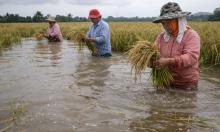“Dead spots” in oceans are increasing
The number of so-called marine “dead spots” lacking oxygen and having no fish, is increasing.
According to the UN experts on environment, there are 150 of such spots, and their number is constantly growing. They can devastate marine fish reserves.
”Dead spots” aroused in the areas having excess of bio-substances, especially nitrogen from agricultural fertilizers, vehicles and industrial enterprises exhausts, people waste. All these exhausts cause microscopic alga phitoplankton to grow. After dying and decomposing, these alga absorb oxygen.
Scientists state that the area of “dead spots” grew twofold and exceeded 70 thousand square kilometers, which is equivalent to the area of Ireland. The “dead zones” become spread worldwide. Previously most of them were located near the East coast of the USA, and now they are located in many other regions, such as the Black and Baltic Seas, Adriatic, the Yellow Sea, the coast of South America, Japan, Australia and New Zealand.
”Dead spots” undermine fishing industry, because they are located mainly in the coastal areas where many fishes spawn and spend their lives.
World Wild Nature Foundation (WWF) is planning to protect the most vulnerable regions such as the Baltic Sea, the Galapagos Islands and the Canaries, the Big Barrier Reef and others. Meanwhile, the WWF accuses Russia of attempts to block international efforts on protecting the Baltic Sea.
The WWF calls Russia to protect the environment of its sea despite the interests of some irresponsible global oil carriers.
Announcing a certain area in the sea or ocean a vulnerable area does not mean introducing strict restrictive measures, but starts international program on improving standards of navigation in the area. These standards are primarily directed at preventing oil spoils.
Subscribe to Pravda.Ru Telegram channel, Facebook, RSS!




